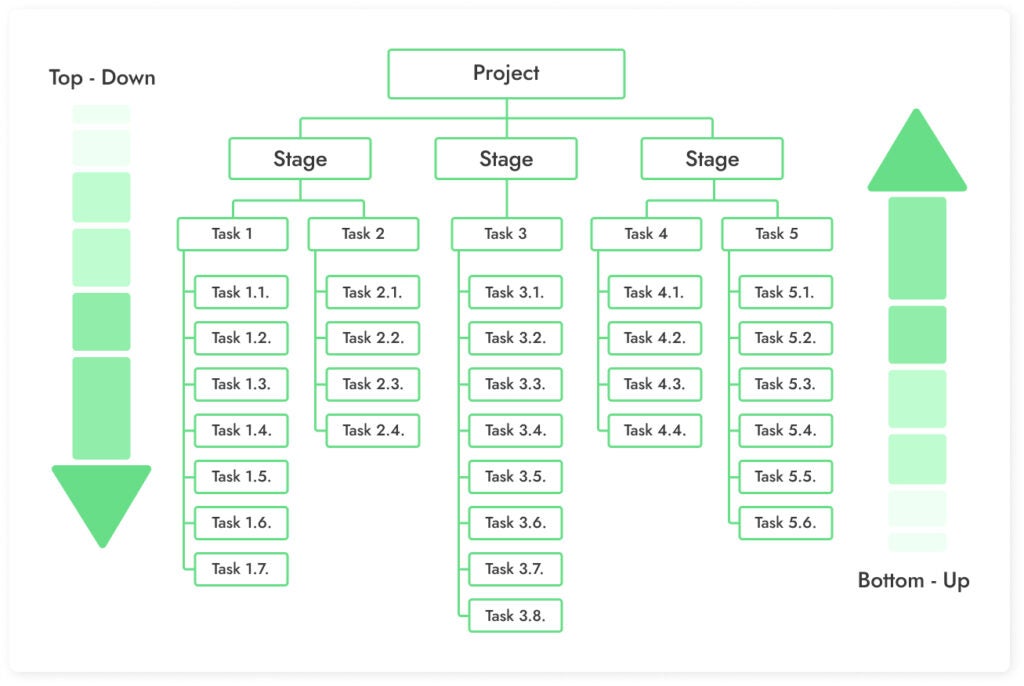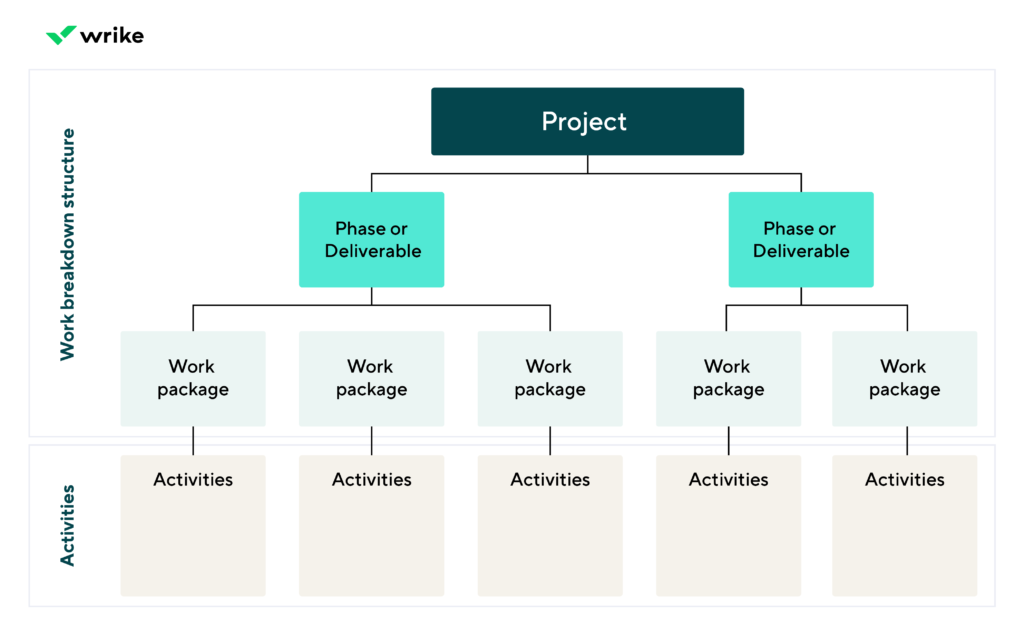Key takeaways
How the Top-Down and Bottom-Up Approach in Project Management Work
The first step to successfully implementing a project strategy is to create a suitable work breakdown structure (WBS) to organize the operations at play.
Work breakdown structures divide projects into more manageable tasks and provide a hierarchical display of a project’s tasks, deliverables, or processes required for its completion. In breaking down the project and segmenting it into smaller components, work breakdown structures simplify the processes of project planning, team management, and progress tracking.
Most program managers favor two primary strategies for developing a successful work breakdown structure: the top-down and bottom-up methods.
The top-down approach to project management works by first tackling the project’s largest deliverable, its outcome, before breaking it down further into smaller tasks. Alternatively, the bottom-up approach is less structured, as it focuses on detailed elements and involves more collaborative coordination from the entire project team.
A work breakdown structure holds high importance as a project management element, and choosing the right method to create your WBS can make or break your project management process.
Read on to learn more about the top-down and bottom-up approach in project management and how they can be applied to create a successful work breakdown structure for your next project.

What Is the Top-Down Model?
A top-down approach addresses a project’s work by first acknowledging the most significant deliverable: the project’s overall outcome. Its processes are carried out under the direction of the project manager, who guides the team on all operations necessary to fulfill the project’s objective.
This model takes a hierarchical approach to leadership, as decisions and knowledge are distributed to the team by the project manager and other key individuals in upper management positions. These higher-ups are the ones who develop the strategies to fulfill the project’s tasks and then direct the rest of the team on how to implement them.
As a project management style, a top-down approach breaks down work from the largest outcome to determine the smaller deliverables necessary to achieve it. As such, team leaders and project leaders maintain the most awareness of the project’s overarching goal and are responsible for leading the project to its successful conclusion.
Benefits of a top-down approach
A top-down approach is often considered to be the most structured approach, with logical sequencing to uncover the best ways to bring the project’s primary objective to fruition.
A significant advantage of a top-down approach is that it streamlines decision-making for the project. By granting the decision-making power to the project managers in charge, this method leverages the experience of those top-level executives with more knowledge and practice in project planning.
Top-down leadership is also designed in a way that reduces confusion and misunderstanding. Because communication always flows from the direction of management to lower-level workers, this method makes it easy for workers to determine who their point of contact is so that they can quickly seek direction or resolve questions.
Putting the directorial guidance in the hands of more experienced upper-level project managers leaves less room for miscommunication, confusion, and problems stemming from inexperience. Instead, workers can follow directions and complete tasks faster through this highly organized process.
When to use the top-down approach
The top-down method is the foundation of many autocratic leadership management processes. Projects that rely on the specialized knowledge of subject matter experts often utilize this approach, as these leading individuals guide the rest of the team using their overarching expertise over the project’s primary outcome.
Many workplaces utilize this management method, especially ones with traditional workflows that rely on the fine-tuned proficiency of the team’s leaders, such as those in manufacturing or healthcare industries.
What Is the Bottom-Up Model?
The bottom-up model focuses more so on the small, intricate tasks required to fulfill a project’s deliverables. Project teams take a collaborative approach to the work breakdown structure, as individuals from varying work departments are involved in determining the actions necessary to fulfill the project’s goals.
This approach requires cooperation from each individual involved in the project’s completion. Together, all involved parties gather and brainstorm in order to identify each task or activity that must be carried out to achieve the project deliverables.
By involving all members of the project team in the initial work breakdown planning phase, the bottom-up model provides project managers with a detailed look into the tasks required by the project and offers insight into the project’s more intricate low-level details.
Benefits of a bottom-up approach
The bottom-up method is highly beneficial for teams seeking a collaborative approach to a work breakdown structure.
When teams are confronted with carrying out processes or solving unfamiliar issues, a bottom-up approach is ideal. It involves leveraging the expertise of all members of the project team, as each individual can contribute into determining the best course of action for fulfilling the project goals.
By involving more low-level members of the team in the planning and decision-making processes, a bottom-up method can reveal more intricate tasks and details that an overarching project manager may not have considered. This can help ensure that all low-level actions are accounted for in the planning process.
A bottom-up approach in project management can strengthen the collaborative skills of a team while harnessing the benefits of all team members and their unique expertise. For projects that require new processes, brainstorming with all team members can be helpful when identifying the best tactics for achieving the project’s goals.
When to use the bottom-up approach
The bottom-up approach is typically utilized by teams that are trying to identify ways to succeed in unfamiliar projects. For example, a team trying to solve a previously unexperienced issue may wish to involve all project team members when determining a solution, as each member can offer their own unique knowledge toward solving the problem.
The creative nature of a bottom-up method makes it ideal for dynamic work industries like marketing and tech.
Areas of Difference between the Top-Down and Bottom-Up Approach in Project Management
Leadership and control
The top-down and bottom-up approach in project management both involve project managers leading the team. However, they differ in their levels of involvement. A bottom-up strategy involves less formal leadership roles. While the project leader is tasked with gathering together all project members, they then take each member’s thoughts and opinions into consideration when developing a plan to fulfill the project’s deliverables.
Alternatively, a top-down method is led primarily by the executive leaders who distribute instructions and guidance to the low-level workers below them. These higher-level individuals leading the project are usually subject matter experts tasked with organizing the project’s goals, outcomes, and deliverables. They then break them down into smaller tasks and determine the order of operations required to achieve them.
Communication flow and employee participation
A top-down method involves communication flowing in one direction, from the highest-level leaders down to the low-level workers. While this leaves less room for brainstorming and creativity that could come from more employee participation, it can also lead to more productivity from lower-level employees, as they are only required to fulfill clearly outlined tasks as directed by their supervisors.
A bottom-up strategy involves collaboration from individuals at all levels, as they work together to brainstorm methods to meet the project’s deliverables. With all employees participating, the roles of these workers are typically more flexible and entail responsibilities that are less clearly structured. This can result in more confusion among the team due to the freely flowing communication, direction, and leadership. Project management tools like the RACI matrix usually come in handy in these cases, as they provide an efficient way to define roles and responsibilities.
Innovation, adaptation, and problem solving
A top-down approach involves following the direction of the senior-level managers and leaders. This means that when a problem occurs, the leaders must first consider it and provide direction to the rest of the team before low-level workers are able to address the issues. This order of operations can lead to delays in the project’s progress, as any adaptations or changes must first be approved by upper management.
Teams using bottom-up methods are able to take more creative strategies for solving problems, adaptation, and innovation. Issues are resolved locally by those working closest to the issue and do not typically require input from higher-ups. Teams are thereby able to adapt and respond to problems more quickly, and workers can utilize innovative strategies that are more experimental.
How to Develop a WBS Using the Top-Down and Bottom-Up Methods
Both the top-down and bottom-up methods can be applied to project management. Of course, these approaches will require different techniques when creating certain types of work breakdown structures.

To develop a beneficial top-down WBS, a project manager should begin by forming a team of subject matter experts. They can then decompose the project outcomes and deliverables and continue to break down the deliverables into smaller tasks and activities necessary to bring them to fruition. It is essential that they create highly structured directives and communicate them to the department heads responsible for each deliverable. This will ensure a one-directional flow of information and reduce confusion about the order of operations and task assignments.
To apply a bottom-up approach to WBS, a project manager would instead begin by considering each individual who would be involved in the project’s completion. The project manager would then be able to collaborate with all parties, either by inviting them to a large workshop or requesting that each of them participate in virtual communication. This way, they would be able to access information from each participant on the details about the activity they will perform, the members involved in each activity, and the related deliverables.
Hybrid Models
Both approaches offer different advantages that can be applied to a project management WBS. Fortunately, combining elements from each can allow project teams to experience more benefits. This is possible by utilizing a hybrid model.
The best way to apply a hybrid model to WBS is by beginning with a top-down approach that is organized logically to decompose the project’s deliverables. Project managers should create an initial draft of the WBS based on the project manager’s knowledge, organizational assets, historical project information, and input from only key subject matter experts, department heads, and functional leads.
Once this is done, the project manager can collaborate with the other low-level workers and individual parties that are more closely involved in the details of each department’s tasks. These parties can then share their insights on whether all tasks are accounted for within the existing WBS draft and offer feedback on ways to update the WBS to achieve a more accurate representation of the work required. Applying the bottom-up approach in this way allows project teams to refine their WBS by validating that all necessary tasks are planned and accounted for.
FAQs
Bottom Line on WBS Approaches
So which approach should you apply when creating your project management WBS? The ideal method can depend on a number of factors including your project’s objectives, team culture, and decision-making preferences.
A top-down method may be more suitable for developing a WBS that is structured and uniform, requiring larger teams with more low-level individuals in need of direction. In this case, a top-down method’s centralized decision-making and aligned structure could be more advantageous for creating an efficient project management WBS.
However, if the project’s overarching goal involves determining an innovative solution to a problem, a bottom-up method may be more helpful for developing a successful WBS. By utilizing this approach, the team can work together, leverage their individual strengths, and adapt to any issues that may present themselves.
Your organization may choose to blend the best aspects of both methods through a hybrid approach. Ultimately, the best approach will depend on the project’s specific needs and desired outcomes.





